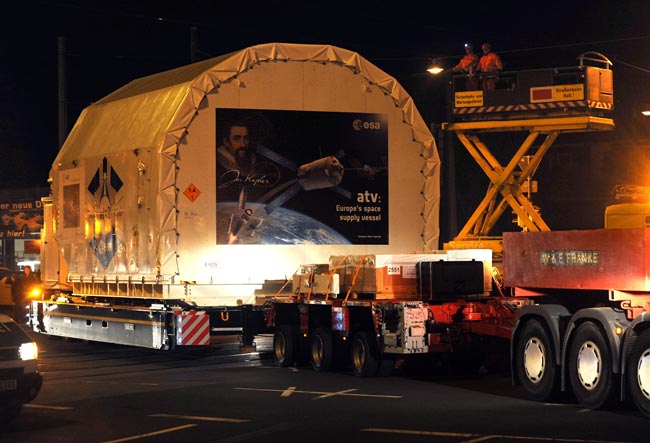Europe Sends Huge New Robot Space Freighter to Launch Site

Europe's second robotic space cargo vessel is headed for itsSouth American launch site in preparation for a delivery mission to theInternational Space Station (ISS) later this year.
The AutomatedTransfer Vehicle 2, or ATV-2, a cargo ship built by the European SpaceAgency (ESA), is slated to launch toward the station in December.
ESA has named the new spacecraft after German astronomer andmathematician Johannes Kepler. The first in the disposable robotic cargo shipfleet was named Jules Verne. It flew a successful debut flight in 2008 anddestroyed itself intentionally at the end of its mission.
The unmanned space freighter underwent extensive systemtesting over the last few months, and has now been approved for the finalpreparation stage prior to its slated launch on an Ariane 5 rocket at the endof 2010.
The ATVJohannes Kepler will now make the journey to Europe's spaceport in Kourou,French Guiana in several sections, accompanied by 59 containers containing testequipment. Once it arrives in Kourou, it will be assembled and extensivelytested before being loaded with cargo and fuel.
"When the US space shuttle retires, ATV will be thelargest vehicle supplying the ISS," said Simonetta Di Pippo, ESA Directorfor Human Spaceflight. "Considering its technological challenges, likeautomatic rendezvous and docking, ATV is the most sophisticated space vehicleever built in Europe."
Europe's debut ATV JulesVerne launched by an Ariane 5 rocket in March 2008 and performed a perfect dockingwith the ISS.
Get the Space.com Newsletter
Breaking space news, the latest updates on rocket launches, skywatching events and more!
These cargo vessels are part of ESA's planned fleet of ATVsthat will ferry propellants, food, water and equipment to the ISS. The ship hasa maximum net cargo capacity of up to 7.7 tons. The composition of this loadcan vary depending on the specific mission.
Once docked to the space station, an ATV can also help withcollision and debris avoidance by using its own engines to correct thestation's orbit, compensating for regular loss of altitude due to drag.
At the end of its mission, the vessel is filled with wasteand burnsup as it heads back into the Earth's atmosphere.
"The technology and experience gained with ATV areassets for Europe and its industrial competitiveness as well as a solid basisfor further developments to position Europe among the leaders in the exploitationand exploration of space, in low Earth orbit and beyond," Di Pippo said.
EADS Astrium is the prime contractor for the ATV, undercontract to ESA. Astrium is already hard at work on the successor to JohannesKepler ? ATV-3 'Edoardo Amaldi'.
- Gallery- Spotting Spaceships From Earth
- TheBest Manned Spaceships of All Time
- Video- ATV's First Successful Mission
Join our Space Forums to keep talking space on the latest missions, night sky and more! And if you have a news tip, correction or comment, let us know at: community@space.com.

Space.com is the premier source of space exploration, innovation and astronomy news, chronicling (and celebrating) humanity's ongoing expansion across the final frontier. Originally founded in 1999, Space.com is, and always has been, the passion of writers and editors who are space fans and also trained journalists. Our current news team consists of Editor-in-Chief Tariq Malik; Editor Hanneke Weitering, Senior Space Writer Mike Wall; Senior Writer Meghan Bartels; Senior Writer Chelsea Gohd, Senior Writer Tereza Pultarova and Staff Writer Alexander Cox, focusing on e-commerce. Senior Producer Steve Spaleta oversees our space videos, with Diana Whitcroft as our Social Media Editor.









